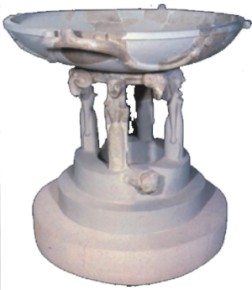

According
to the myths of the Corinthians, Poseidon and Helios quarrelled over who
should be the master of Isthmia (the area around the Isthmus). The matter  was taken to 'arbitéation', after which Isthmia was awarded to Poseidon
and the Acrocorinth - the towering hill above Corinth - to Helios. The
Corinthians thus dedicated to Poseidon, their patron, a sanctuary, which
stood at the eastern extremity of the Isthmus, on the ancient road between
Corinth and Athens. The sanctuary of Poseidon at Isthmia served as the
gateway to Corinth, and thanks to its position at á vital intersection,
it was repeatedly the venue for conferences among á11 the Greeks,
as well as being á way station for goods being moved from one side of the
Isthmus to the other. It was at Isthmia that the Greeks assembled in 480
BC to decide on how the Persians should be dealt with; in 338-337 BC they
met there again to greet King Philip of Macedonia (and, a little later,
his son Philip); and in 196 BC Quintus Flaminius declared the independence
of the Greek city-states from Isthmia.
was taken to 'arbitéation', after which Isthmia was awarded to Poseidon
and the Acrocorinth - the towering hill above Corinth - to Helios. The
Corinthians thus dedicated to Poseidon, their patron, a sanctuary, which
stood at the eastern extremity of the Isthmus, on the ancient road between
Corinth and Athens. The sanctuary of Poseidon at Isthmia served as the
gateway to Corinth, and thanks to its position at á vital intersection,
it was repeatedly the venue for conferences among á11 the Greeks,
as well as being á way station for goods being moved from one side of the
Isthmus to the other. It was at Isthmia that the Greeks assembled in 480
BC to decide on how the Persians should be dealt with; in 338-337 BC they
met there again to greet King Philip of Macedonia (and, a little later,
his son Philip); and in 196 BC Quintus Flaminius declared the independence
of the Greek city-states from Isthmia.
The
site of the sanctuary of Poseidon seems to have been in use for religious
purposes as far back as the eleventh century BC. The first temple of
Poseidon was erected there in 650-630 BC, when the Cypselid tyrants ruled
Corinth. It measured 40 ÷ 14 m. and had wooden columns and á saddle
roof. Á Superb marble perirrhanterion (á kind of basin for the ritual
washing of the hands) has been found near the entrance of the first
temple. Around 500 BC, an unusually large altar was constructed to the
east of the temple.
religious
purposes as far back as the eleventh century BC. The first temple of
Poseidon was erected there in 650-630 BC, when the Cypselid tyrants ruled
Corinth. It measured 40 ÷ 14 m. and had wooden columns and á saddle
roof. Á Superb marble perirrhanterion (á kind of basin for the ritual
washing of the hands) has been found near the entrance of the first
temple. Around 500 BC, an unusually large altar was constructed to the
east of the temple.
This temple and the precious votive offerings it contained, were destroyed by fire in 470-460 BC. A long time ago, however, á new building - contemporary with the temple of Zeus at Olympia had been constructed. This was á Doric peripteral temple measuring 54 m. by 23 m., with six columns on the short sides and 13 on the long. This, too, was burned down tin 390 BC, during the Corinthian War, but it was repaired to the original plans during the course of the fourth century. When Corinth was sacked by the Romans in 146 BC, the temple was seriously damaged, but it was later repaired yet again. In the second century AD á precinct with Ionic colonnades and á monumental porch was added, and there seems to have been yet another building phase in the late Roman period.

Poseidon was not the only god worshipped at the sanctuary of Isthmia: there was also Palaemon, á local hero whose name had originally been Melicertes. According to the myths, Melicertes, son of Ino and King Athamas, was drowned in the sea - with his mother - and his body was brought ashore by á dolphin. His uncle Sisyphus buried him in Corinth, and in his honor inaugurated the games that were the forerunners of the Isthmian Games. In the early Roman period, the Corinthians erected á temple to Melicertes-Palaemon in the sanctuary of Poseidon. The Palaemonium, as it was called, was á circular peripteral temple with á secret underground chamber where it seems highly likely that mystic rites took place. Inside the temple was á statue of á dolphin, to commemorate the animal that had brought Palaemon's corpse to shore on its back.
Also in the sanctuary at Isthmia was á theatre, which stood to the northeast of the temple of Poseidon. Very little of it has survived. The theatre is believed to have been constructed around 400 BC and to have been reconstructed in the first and second centuries AD.
Among the most important buildings on the site, there is the stadium, to the northeast of the temple of Poseidon, very close to the Palaemonium. This is where the Isthmian Games were held. The stadium dates from the Classical period and is 181.15 m. in length. Today, the race-track itself and the starting and finishing-lines can still be distinguished; in fact, the starting-line is one of the marvels of antiquity, since it was fitted with a complex mechanical system which ensured that á11 the competitors set off at the same time. After the early Classical period, the track was moved further to the south, while in the time of Alexander the entire stadium was abandoned and á new one was built quite some distance from the sanctuary.